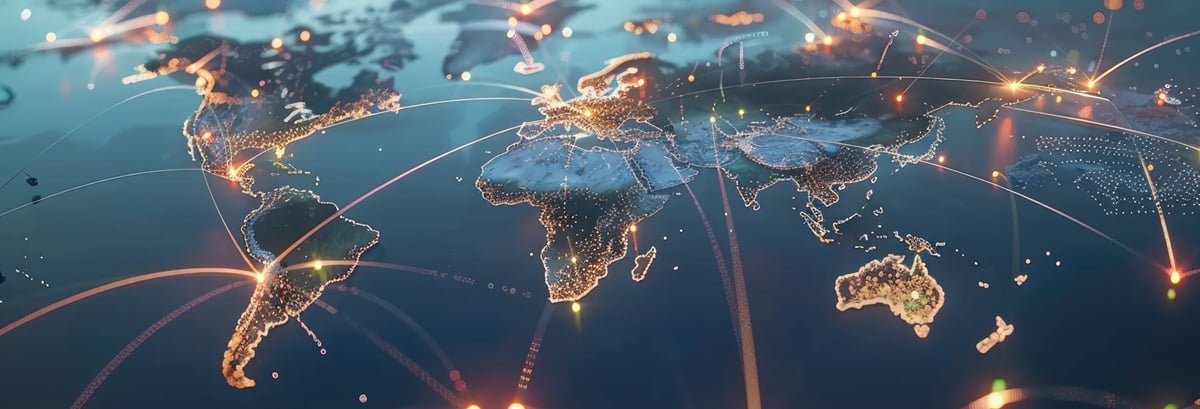Cristina Leon Vera | 17/10/2024
Freight transport involves more than just moving goods from point A to point B; it also entails managing confidential data and documents throughout the supply chain. Ensuring the security of this sensitive information is crucial.
To achieve this, virtual environments have been developed that enhance administrative agility, safeguard data, and support a more sustainable and efficient service. “Digital corridors arise from the need to unify all stakeholders in supply chain management within a single digital ecosystem, leveraging technologies like Blockchain to ensure document security and integrity,” explains Cristina Martín Lorenzo, CEO of Usyncro, a Spanish initiative with years of successful experience and which has been endorsed by UNCTAD (the UN Conference on Trade and Development).
This approach enables manufacturers, couriers, customers, banks, customs agents, freight forwarders and authorities in the various countries through which goods transit to share shipment-related information while maintaining data governance. This streamlines operations, reduces the risk of fraud and eliminates both paperwork and unnecessary travel.
A paradigm change
Although the technological transition is happening globally, transformation is not always straightforward, especially in traditional sectors that require paradigm shifts. “The effort towards digitization is significant. The logistics and transport sectors still rely on paper-based documentation, and legislation to support this change has yet to be fully implemented. However, European directives, such as the CSRD and requirements related to the transport of certain products (like the CBAM), are paving the way for more sustainable operations,” says the expert.
In this context, Usyncro proposes incorporating features that align with the evolution of European customs management while also addressing the major challenge of technology adoption. “Professionals may fear being replaced, but the goal is actually to elevate the value of human work,” the expert states. Far from simply changing formats, digitalization seeks to create a global digital environment where technologies like Artificial Intelligence (AI), machine learning, Blockchain, and robotics are integral to the present.
These technologies, especially Blockchain, enhance supply chains by ensuring the inalterability of critical documentation, providing traceability, and enabling decentralized access to data. “Combined with AI, it makes it possible to automate many repetitive processes and it quickly identifies errors, significantly reducing the risk of fraud,” explains Martín Lorenzo. This approach enables buyers, sellers, and other stakeholders to authenticate data in their commercial exchanges, streamlining procedures that might otherwise require 20 to 50 steps. They would simply upload a document digitally and share it within a unified virtual space.
High impact on risk management
Digital corridors facilitate information sharing within a secure environment, ensuring data governance while extending accessibility to authorities across different countries. “It’s important to remember that logistics involves highly sensitive and strategic data, making it essential for each participant to be confident that the documentation shared remains unaltered,” states Usyncro. The security and transparency provided by Blockchain have paved the way for a range of ancillary services for all participants in the supply chain. This includes coordinating the documentation associated with an operation among all parties involved through a single, distributed, and synchronized ledger that is accessible and verifiable by all transaction participants, including official institutions like customs or tax authorities.
Furthermore, “the assurances offered by this technology are valuable for securing cargo insurance or financing, leading to improvements in premiums or terms thanks to the provision of transparent and validated documentation. Additionally, the traceability and ability to create predictive models in response to global conflicts or supply chain risks represent a significant advancement in the insurance sector and in the valuation of certain types of cargo,” explains Martín Lorenzo.
Progressive development
How has it evolved, and what key milestones have marked this successful journey toward UN recognition?
The consolidation of this technology has gone through various phases of development, as well as tests of different magnitudes and distances to verify its effectiveness. Usyncro’s story began in 2018, driven by the experience of its CEO, Cristina Martín, who started with a customs-focused project. By 2021, it had become a comprehensive solution. “This is when the SaaS platform—open, flexible, and interoperable with other technologies—was born, with the vision of bringing disruptive technologies like AI and Blockchain to businesses of all sizes,” says the founder. She adds that the platform also aims to “reduce the carbon footprint of operations through digitalization and the connectivity of all supply chain actors, with a strong commitment to advancing the Sustainable Development Goals (SDGs).” “Interoperability between platforms and technologies is part of our DNA to bring about safer, more agile, and more sustainable supply chain management,” she concludes.
The contributor to this article is…

Cristina Martín Lorenzo is a Chemical Engineer by training, holds an Executive MBA from IE, and is certified as an Air Freight and Transport Operator. Nearly 20 years ago, she founded the freight forwarding company ATML, and she currently serves as the CEO of Usyncro, a multi-modal solution that won the 2024 United Nations Innovation Challenge (UNCTAD). In 2023, the solution was also recognized as the Best Technology Platform for Trade by the international organization Trade Finance Global. Martín works in the digital transformation of the logistics sector, serving on the board of key associations such as ATEIA Madrid and Foro Madcargo. She is also a board member of the ALASTRIA network and the Blockchain Cluster of the Community of Madrid, and she is part of ALACAT’s Technology Commission, working to promote digital customs collaboration between Spain and Latin America.






